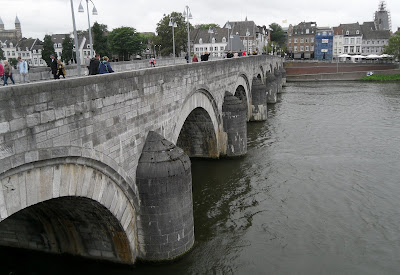Well, our cruising "quest" for the season has been reached--we moored in Maasbracht on Tuesday, August 31. The shipyard that was our destination in Maasbracht--Tinneman's Floating Solutions--has us moored to a very secure floating "dock", an 80 m x 8.2 m 1205-ton commercial barge whose owners are currently on vacation.
 |
| We're moored just downstream from the last lock we passed through on the Juliana Canal, rafting on a barge 4 times our length. It's really good exercise just making the trek to go ashore. |
As we are now in the Netherlands, the Meuse River has become the Maas River, and has lent its name to the two Dutch towns we have stopped in.
While we feel very secure here, and we are even able to plug into power onshore, we are exposed to all manner of boats passing us by on the canal. After all, Maasbracht is the largest inland port in the Netherlands. The wake created by the passing boats sometimes has us bobbing up and down a little more than we would like. It's not usually the 110-meter or 135-meter behemoths that give us the most problems, it's the small pleasure cruisers that plow the most water and create the biggest waves.
Today is finally sunny and warm, but the days we spent in Maastricht were not quite so summery. Still, we found Maastricht to be a lovely small city. It's a university town at the southern tip of the Netherlands whose history as a settlement goes back at least to the Roman era and possibly earlier. It was an important trade, manufacturing, and cultural center in the Middle Ages; a fortified city in the 16th to 18th centuries; and an industrial center in the 19th century. It has, at various times, been under the control of the Spanish, the Dutch, the French, and finally, the Dutch again (since the 1830's).
 |
| Our mooring (at left) in the old port on the fringe of the historic center. As in Huy, an interesting pivot was needed to position ourselves for the exit. |
 |
| The port was full of panhandlers who had no shame in approaching us for a handout. |
 |
| The outdoor eating area of this café was packed on Saturday. When we walked by on Sunday (late morning), it was getting prepped for crowds. |
 |
| The Gothic Church of St John, dating back to the 14th century. |
 |
| Wall built in 1229 as part of the first medieval city wall. |
 |
| Lon at the Helpoort gate, the oldest city gate in the Netherlands. |
 |
| Lunch on Sunday was at this small cafe in the shadow of the Pater Vincktoren and portions of the first and second city walls. |
 |
| We crossed the historic 13th century Sint Servaasbrug. |
 |
| On the side of the Maas opposite the historic center, a portion of the Sint Servaasbrug has been removed to install a lift bridge to accommodate commercial boat traffic. |
 |
| A great-looking combination of buildings. The building with the red lighting is a 1786 guardhouse repurposed for commercial uses, and behind it, the eastern aspect of the Basilica of Our Lady. |
 |
 |
| Soon after leaving Maastricht, we passed into the Juliana Canal. We passed under this floodgate, which can be dropped in times of flooding to mitigate high water from the Maas. |
 |
| This shows, in red, the route we covered this summer. Auxonne is the red flag at the bottom, Maasbracht the green flag at the top. The yellow flags are waypoints to make sure the route is correct. |
 |
| And here we are, at the topographical low point of the season. From an emotional standpoint we are riding high and thrilled to be here. |



Congratulations! What an accomplishment! So interesting to see all of the very old and historic towns and buildings. Praying for all the requirements for a safe trip back to the States. And for your health. Enjoy the rest of this beautiful land!
ReplyDeleteCongratulations..you made it to journey's end. What an amazing feat! Thank you for informing, educating and inspiring us on your travels!! The pictures have been first rate..and wonderful. Continuing to pray for the rest os your journey.
ReplyDelete